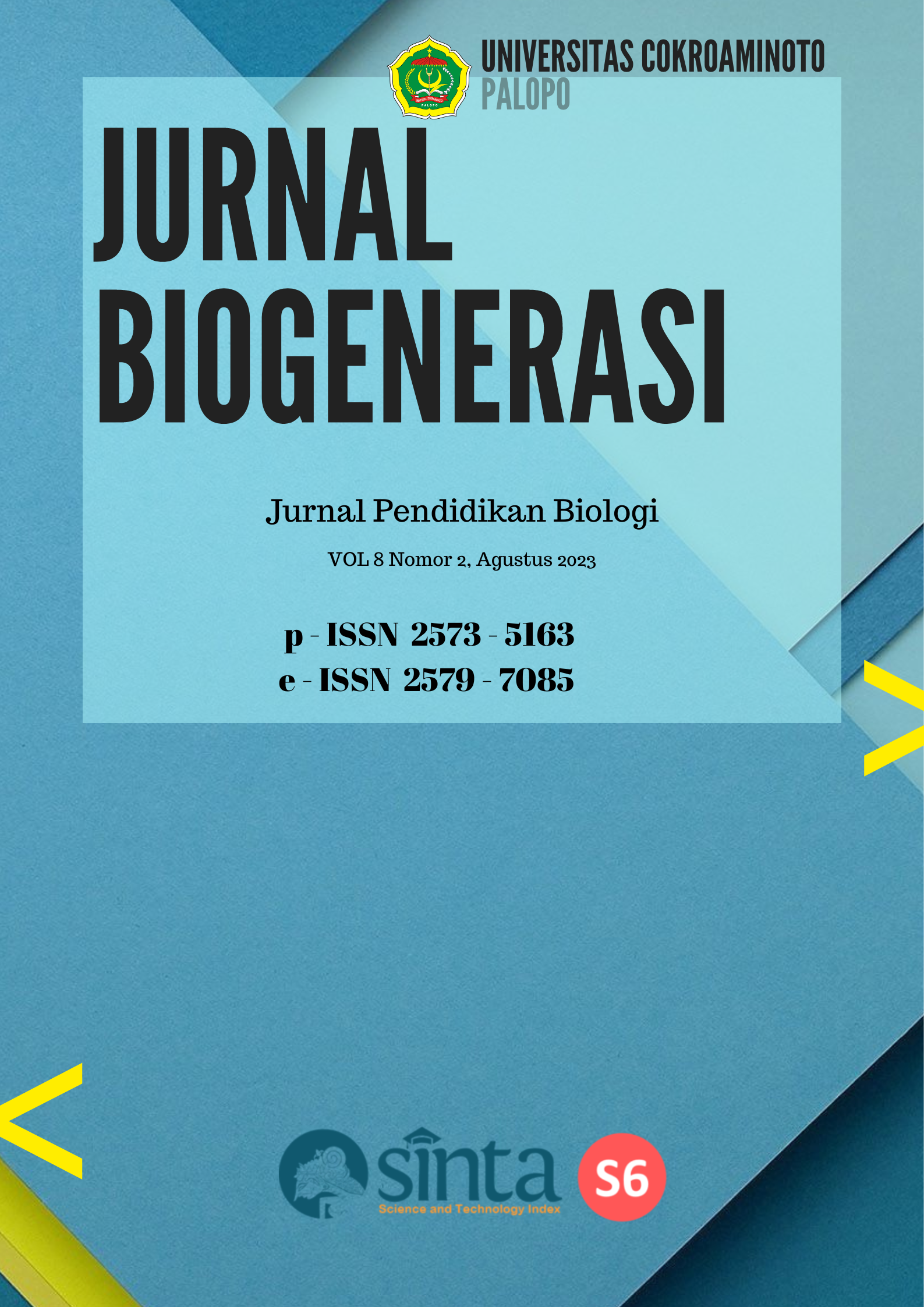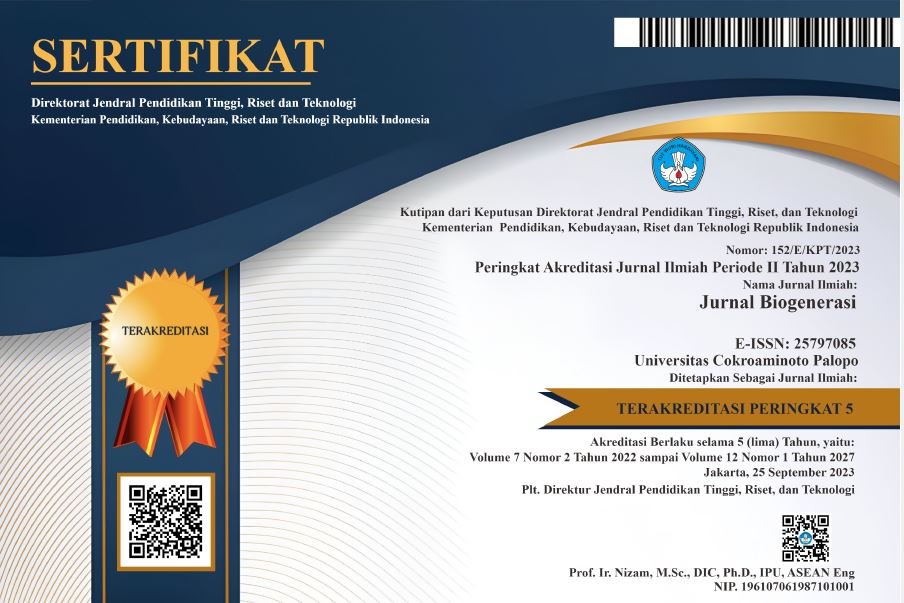PENGEMBAGAN UNIT PEMBELAJARAN DENGAN SETTING FLIPPED CLASSROOM BERBASIS GUIDED INQUIRY MATERI SISTEM PEREDARAN DARAH
DOI:
https://doi.org/10.30605/biogenerasi.v8i2.2366Keywords:
Learning Units, Flipped Classroom, Guided InquiryAbstract
In producing effective learning, a teacher needs learning tools that can support the learning process in the classroom. For this reason, teachers need learning tools in the form of teacher guidebooks to help the learning process, especially learning biology. This study aims to produce a learning unit with a flipped classroom learning setting based on guided inquiry on circulatory system material for class XI SMA/MA. This research is a development research that adapts the ADDIE development model which consists of analysis stages, namely needs analysis, content analysis, structure analysis, and objective analysis, the design stage is carried out by designing products consisting of cover design and content design, the development stage is tested for validity by an expert validator, the implementation stage is carried out by applying the product with practicality and effectiveness tests, and the evaluation stage is carried out by re-evaluating the product based on the practicality test. The developed learning unit is equipped with core competencies, basic competencies, learning materials, flipped classroom learning stages, guided inquiry learning scenarios, learning assessments, and student worksheets. The results showed practicality with an average score on the teacher and student response questionnaire, namely 86.6 and 84.02, included in the practical category.
Downloads
References
Chaer, Muhammad, Ainun., Nurhayati B., & Muhiddin Palenari. (2021). Profil Hasil Belajar peserta Didik Kelas X MIPA SMA Pada Materi Virus Menggunakan Model Flipped Classroom. Jurnal Biology and learning, 4(1), 8-18.
Enfield, J. (2013). Looking at the Impact of the Flipped Classroom Model of Intruction on Undergraduate Multimedia Student at CSUN. TechTrends, 57(6), 14-27.
Guswita, Zildiya., & Mawardi. (2021). Validitas dan Praktikalitas Flipped Classroom Berbasis Inkuiri Terbimbing Pada Materi Larutan Asam Basa. Jurnal Pendidikan Tambusai, 5(2), 2992-2997.
Hamimi, Lia., M. Ikhsan., & Zainal, Abidin. (2018). Pengembangan Perangkat Pembelajaran Pembuktian Menggunakan Model Pembelajaran Guided Inquiry untuk Meningkatkan Kemampuan Geometri Siswa Sekolah Menengah Atas. Jurnal Didaktik Matematika, 5(1), 16-26.
Irsalina, Ayu., & Kusumawati, Dwiningsih. (2018). Analisis kepraktisan Pengembangan Lembar Kegiatan Peserta Didik (LKPD) Berorientasi Blended learning Pada Materi Asam Basa. Jurnal Kimia Dan Pendidikan Kimia, 3(3), 171-182.
McCarthy, J. (2016). Reflections On A Flipped Classroom In First Year Higher Education. Issues in Educational Research, 26(2), 332-350.
Muthmainnah, Rahmita, Nurul., Mega, Purnamasari. (2019). Analisis Faktor Penyebab Peserta Didik Dengan IQ Tinggi Memperoleh Hasil Belajar Matematika Rendah. Jurnal Pendidikan Matematika dan Matematika, 5(1), 81-86.
Pane, Aprida., & Muhammad, darwis, dasopang. (2017). Belajar dan pembelajaran. Jurnal Kajian Ilmu Keislaman, 3(2), 333-3552.
Purnama, S. 2013. Metode Penelitian dan Pengembangan. Literasi, 4(1), 19-32.
Santrock, J, W. (2010). Psikologi Pendidikan Edisi Kedua. Jakarta: Kencana.
Sugiri, Wiku, Aji., Sigit, Priatmoko., & Basori. (2020). Flipped Classroom Learning Design The ASSURI Model. Jurnal Teknodika. 18(2), 45-47.
Sukma., Laili, Komariyah., & Muliati, syam. (2016). Pengaruh Model Pembelajaran Inkuiri Terbimbing (Guided Inquiry) dan Motivasi Terhadap Hasil Belajar Fisika Siswa. Saintifikasi, 18(1), 599-63.
Ubaidillah, M. (2019). Pengaruh Flipped Classroom Berbasis Teknologi Informasi Pada Mata Pelajaran Fiqih Di MTS Al-Chasnaniyah Surabaya. Jurnal Islamika, 19(1). 34-45.
Yulianti, Putri,. Afrizal, Sano., Ifdil. (2016). Self Regulated Learning Siswa Dilihat Dari Hasil belajar. Jurnal Pendidikan Indonesia, 2(1), 98-102
Downloads
Published
How to Cite
Issue
Section
License
In submitting the manuscript to the journal, the authors certify that:
- They are authorized by their co-authors to enter into these arrangements.
- The work described has not been formally published before, except in the form of an abstract or as part of a published lecture, review, thesis, or overlay journal.
- That it is not under consideration for publication elsewhere,
- That its publication has been approved by all the author(s) and by the responsible authorities – tacitly or explicitly – of the institutes where the work has been carried out.
- They secure the right to reproduce any material that has already been published or copyrighted elsewhere.
- They agree to the following license and copyright agreement.
License and Copyright Agreement
Authors who publish with this journal agree to the following terms:
- Authors retain copyright and grant the journal right of first publication with the work simultaneously licensed under Creative Commons Attribution License (CC BY 4.0) that allows others to share the work with an acknowledgment of the work's authorship and initial publication in this journal.
- Authors are able to enter into separate, additional contractual arrangements for the non-exclusive distribution of the journal's published version of the work (e.g., post it to an institutional repository or publish it in a book), with an acknowledgment of its initial publication in this journal.
- Authors are permitted and encouraged to post their work online (e.g., in institutional repositories or on their website) prior to and during the submission process, as it can lead to productive exchanges, as well as earlier and greater citation of published work.



.png)

